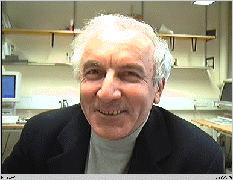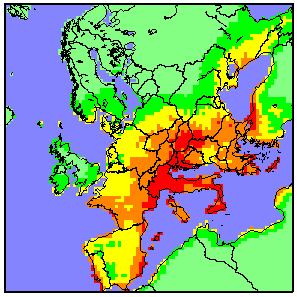Home page of Zahari Zlatev (click here to see
shortened version in Bulgarian)

|
CURRICULUM VITAE Zahari Zlatev (Захари
Златев)
Aarhus University
|
|
E-mail address: zz@dmu.dk
or Zlatevi@adslhome.dk
Web-sites: http://www.dmu.dk/AtmosphericEnvironment/staff/zlatev.htm
http://www.dmu.dk/AtmosphericEnvironment/DEM/
Biographical data
|
15.08.1939 |
Born in Dobrich, Bulgaria (at that time Dobrich was a Romanian town) |
|
1957 |
Finished a secondary school (gymnasium) in Dobrich |
|
1962 |
MSc in Mathematics (special subject: Numerical Analysis), University of Sofia, Bulgaria |
|
1969 |
PhD in Numerical Analysis, Sct. Petersburg University, Russia (then Leningrad, USSR) |
|
1974-1977 |
Research Fellow (Institute of Numerical Analysis, Technical University of Denmark) |
|
1977-1978 |
Assistant Professor (Mathematics Institute, University of Copenhagen) |
|
1978-1979 |
Assistant Professor (Institute of Mathematics and Statistics, Royal Veterinary and Agricultural University, Copenhagen, Denmark) |
|
1979-1980 |
Associated Professor (Computer Science Department, University of Aarhus, Denmark) |
|
After 1980 |
Senior Researcher, now emeritus, at the Department of Environmental Science, University of Aarhus, Denmark (the name of the institution changed several times, but the members of the staff remained practically the same; one of the former names was National Environmental Research Institute, NERI). |
|
1988-1989 |
Senior Computer Science Researcher in the Centre for Supercomputing Research and Development (CSRD) at the University of Illinois at Urbana-Champaign (Illinois, USA) |
|
Hobbies |
Running (participated in five half marathons in
Copenhagen (2015, 2016, 2017, 2018 and 2019). Chess Bridge Historical Studies: resulted in five fiction
books treating some events from the Bulgarian history, which took place many
years ago. The main characters in these books are Bulgarian rulers from the
dynasty Dulo (the first Bulgarian dynasty for which some reliable messages in
medieval chronicles have been found found). These books, written in
Bulgarian and edited by Nadia Deleva,
were published by TRUD Publishing
House Ltd (Sofia, Bulgaria). |
|
Honours |
2009:
Received the medal “Marin Drinov” from the
Bulgarian Academy of Science for achievements in the areas of Numerical Analysis,
Scientific Computing, Environmental Modelling and Influence of Climate
Changes on Pollution Levels as well as for a successful collaboration with
many Bulgarian scientists. 2019:
Received a second medal from the Bulgarian Academy of Sciences. |
|
I was a member for several other societies while I was still active researcher. |
|
http://www.dmu.dk/AtmosphericEnvironment/gloream/
http://www.dmu.dk/AtmosphericEnvironment/remape/remape.htm
GENERAL INFORMATION ABOUT RESEARCH ACTIVITIES
Major Fields of the Research Investigations
- Applied Mathematics
- Numerical Analysis
- Scientific Computing
- Parallel Computations
- Impact of Climatic Changes on Pollution Levels in Denmark and in different European countries
- Large-scale Air Pollution Modelling Studied by the Unified Danish Eulerian Model (UNI-DEM)
- Long-term Air Pollution Studies by Using Systematically Many Sequences of Scenarios
- Damaging Effects from High Pollution Levels on Crops and Human Health
- Implementation of Non-linear Chemical Schemes in Large-scale Air Pollution Models
- Influence of Biogenic Emissions on High Ozone Levels
- Variational Data Assimilation Algorithms
- Richardson Extrapolation – studying stability properties
Scientific achievements
- Ph D thesis (Sct. Petersburg University, Russian Federation)
- Sеvеn monographs in the areas of Applied Mathematics and Environmental Modelling (two in Springer, two in Kluwer, one in De Gruyter, one in MIR, one in Elsevier)
- Editor of six proceedings volumes from international scientific meetings
- Guest-editor of twenty special issues of international scientific journals
- 152 papers in international journals
- 233 presentations at international scientific meetings
- More than 200 institutional reports
Click here
to see information about monographs, proceeding volumes and special issues
Click here to see the publications with most
citations (according to Google)
Click here to see the list of all scientific publications
|
Reviewer · Computing Reviews (http://www.reviews.com) · Mathematical Reviews (http://www.ams.org/mresubs) Referee
|
|
Organizer of workshops and mini-symposia at international conferences
· Four workshops (1992, 1993, 1995 and 1996)
· NATO ARW (Advanced Research Workshop) in Sofia (Bulgaria) 1998
· Twenty-five mini-symposia at international conferences: Stanford (California, USA), Hamburg (Germany), Toronto (Canada), San Francisco (USA), Czestochowa (Poland), Copenhagen (Denmark), Limassol (Cyprus) and many times in different Bulgarian sites.
- Member of the organizing committee of international conferences: many times.
Courses given at foreign universities
- Computational and Numerical Challenges in Environmental Modelling (February 2002) University of Toronto, http://www.fields.utoronto.ca/scientific/01-02/numerical/cources/zlatev (the materials from this course were used in a text-book with the same name)
Short
information about the Unified Danish Eulerian Model
The development of the Unified Danish Eulerian Model (UNI-DEM) was started in 1980. Many colleagues from the Department of Environmental Science and the Technical University of Denmark contributed in the efforts to make this model more flexible and more efficient: first and foremost, Jesper H. Christensen, Jørgen Brandt, Carsten Ambelas Skjøth, Per Grove Thomsen, Jerzy Wasniewski and Claus Bendtsen. Several scientists from the Bulgarian Academy of Sciences (Krassimir Georgiev, Ivan Dimov, Tzvetan Ostromsky) have also very essential contributions, mainly for improving the numerical algorithms and the parallel performance.
The geographical spatial domain of UNI-DEM contains the whole of Europe and some of its surroundings (see the plot given above).
The model is three-dimensional and can be run on several different horizontal scales. The spatial discretization obtained by applying 480 x 480=230400 horizontal grid-points is the finest one. The number of the used in this case (10 km x 10 km) horizontal sells is 230400. Ten non-equidistant vertical layers are used in all versions of the model. This means that the semi-discretized model contains a system of 2304000 which was usually run over a one-year time-interval by using a stepsize of 30 seconds. These short details explain the enormous computational difficulties which have to be overcome. Much more information about UNI-DEM can be found in the monograph: Z. Zlatev and I. Dimov: “Computational and Numerical Challenges in Environmental Modelling”, Studies in Computational Mathematics. Vol. 13, Elsevier, 2006.
Different scenarios have been developed and used to study effects of climatic changes on high pollution levels, which might be harmful for plants, animals and human beings: more details can be found for example in Z. Zlatev: “Impact of future climate changes on high ozone levels in European suburban areas”, Climatic Change, Vol. 101, No. 3-4, (2010), pp. 447-483.
Pollution levels in Hungary were studied together with scientists from the University of Budapest (Ágnes Havasi and István Faragó).
Pollution levels in England and the North Sea were studied together with either Roy M. Harrison from the University of Birmingham or Vassil Alexandrov from the University of Reading as well as with some of their co-workers.
Pollution levels in Bulgaria and in the Balkan Peninsula were studied together with scientists from the Bulgarian Academy of Sciences (Ivan Dimov, Krassimir Georgiev, Tzvetan Ostromsky, Dimiter Syrakov and Kostadin Ganev).
The group of Ivan Dimov from the Bulgarian Academy of Sciences (first and foremost, Tzvetan Ostromsky, Rayna Georgieva, Venelin Todorov) used furthermore the model in different sensitivity studies.
UNI-DEM was used in two comprehensive studies of European large-scale air pollution models within the project EUROTAC-2. The first study was coordinated by Heinz Hass (Ford Forschungzentrum, Aachen, Germany) and the second one by Michiel Roemer (TNO, Delft, The Netherlands).
The applications listed above were described in several papers published in well-known international scientific journals.
It is worthwhile to emphasize here the fact that scientists from the Department of Environmental Study of the Aarhus University (Jesper H. Christensen, Jørgen Brandt and several others) developed a complicated and very efficient hemi-spherical model for studying transport of air pollutants in the Northern hemi-sphere.
Some results obtained in the Danish area over a period of sixteen consecutive years are shown below (results obtained by using measurements are also given when available).

Ammonia-ammonium levels in
Denmark in the period 1989-2004
Three photos are attached
below:
(a) receiving a medal from the vice-president Kostadin Ganev of the Bulgarian Academy of Sciences at the international conference on High-speed Computations held in September 2019 in the Bulgarian winter resort Borovets,
(b) the front page of one of my historical books published (in Bulgarian) by the “TRUD Publishing House”, Sofia,
(c)
finishing successfully my fifth half-marathon in September
2019 in Copenhagen.



Click here to see
shortened version in Bulgarian
